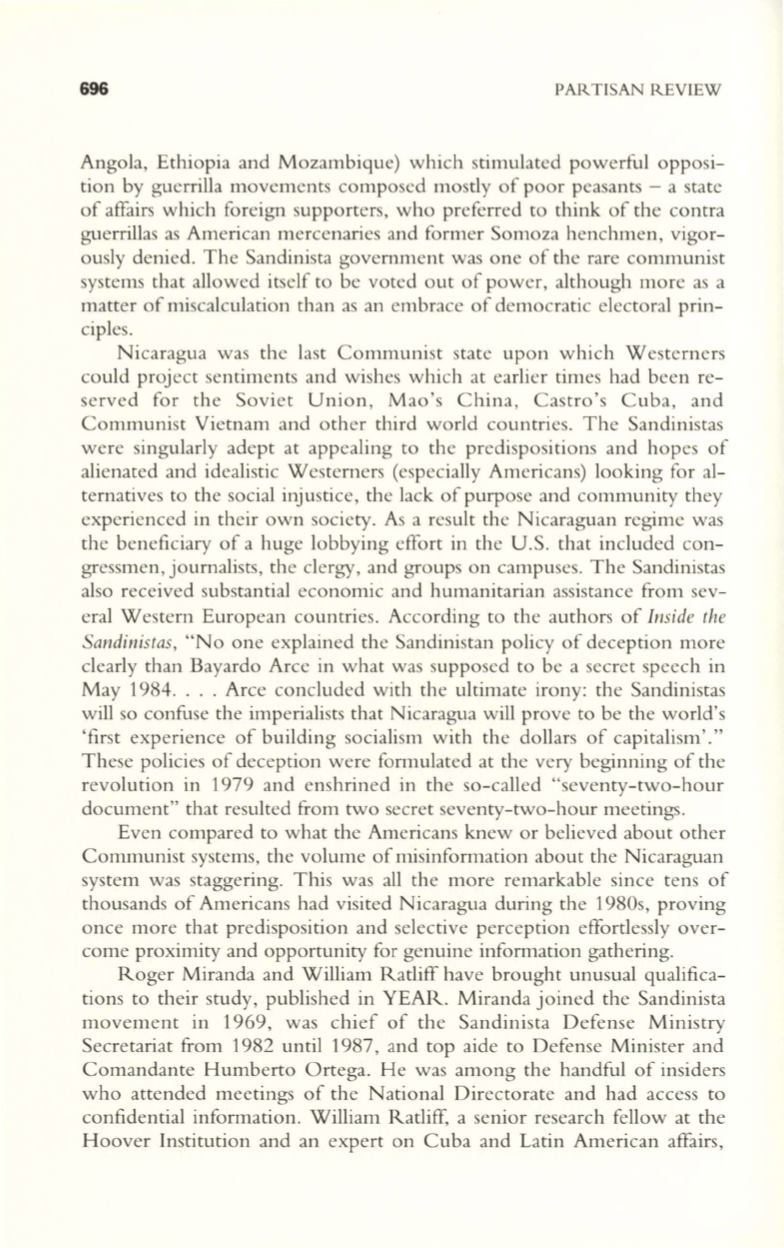
696
PARTISAN REV IEW
Angola, Ethiopia and Mozambique) which stimulated powerful opposi–
tion by guerrilla movements composed mostly of poor peasants - a state
of affairs which foreign supporters, who preferred to think of the contra
guerrillas as American mercenaries and former Somoza henchmen, vigor–
ously denied. The Sandinista government was one of the rare communist
systems that allowed itself to be voted out of power, although more as a
matter of miscalculation than as an embrace of democratic electoral prin–
ciples.
Nicaragua was the last Communist state upon which Westerners
could project sentiments and wishes which at earlier times had been re–
served for the Soviet Union, Mao's China, Castro's Cuba, and
Communist Vietnam and other third world countries. The Sandinistas
were singularly adept at appealing
to
the predispositions and hopes of
alienated and idealistic Westerners (especially Americans) looking for al–
ternatives to the social injustice, the lack of purpose and community they
experienced in their own society. As a result the Nicaraguan regime was
the beneficiary of a huge lobbying effort in the U.S. that included con–
gressmen, journalists, the clergy, and groups on campuses. The Sandinistas
also received substantial economic and humanitarian assistance from sev–
eral Western European countries. According to the authors of
Inside the
Sandinistas,
"No one explained the Sandinistan policy of deception more
clearly than Bayardo Arce in what was supposed to be a secret speech in
May 1984.... Arce concluded with the ultimate irony: the Sandinistas
will so confuse the imperialists that Nicaragua will prove to be the world's
'first experience of building socialism with the dollars of capitalism'."
These policies of deception were formulated at the very beginning of the
revolution in 1979 and enshrined in the so- called "seventy-two-hour
document" that resulted from two secret seventy-two-hour meetings.
Even compared to what the Americans knew or believed about other
Communist systems, the volume of misinformation about the Nicaraguan
system was staggering. This was all the more remarkable since tens of
thousands of Americans had visited Nicaragua during the 1980s, proving
once more that predisposition and selective perception effortlessly over–
come proximity and opportunity for genuine information gathering.
Roger Miranda and William Ratliff have brought unusual qualifica–
tions to their study, published in YEAR. Miranda joined the Sandinista
movement in 1969, was chief of the Sandinista Defense Ministry
Secretariat from 1982 until 1987, and top aide to Defense Minister and
Comandante Humberto Ortega. He was among the handful of insiders
who attended meetings of the National Directorate and had access to
confidential information. William Ratliff, a senior research fellow at the
Hoover Institution and an expert on Cuba and Latin American affairs,


